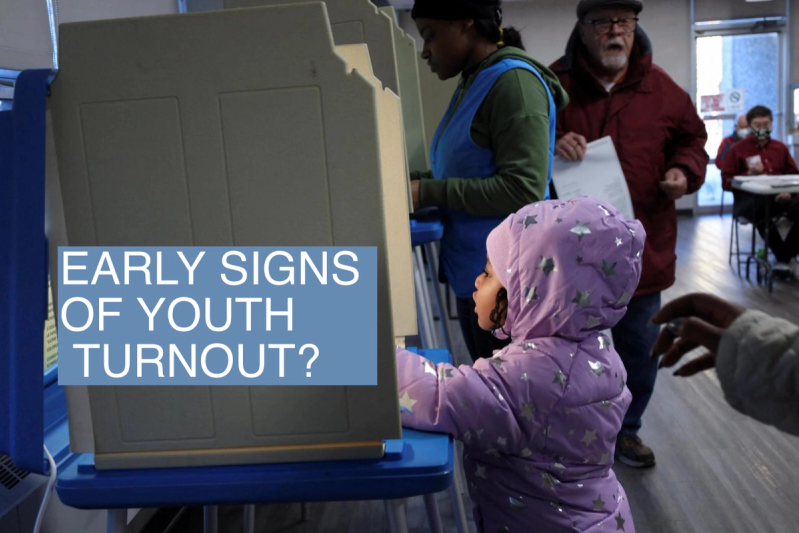
It will take weeks to determine every midterm election winner and potentially even control of the House or Senate if Democrats hold their own. But it shouldn’t take long to figure out the direction of the results after the first returns roll in from Indiana and Kentucky.
Here’s a guide to what to look for every hour of the night — the races, counties, and candidates that will help tell you where things are heading as early as possible.
6 PM ET: Early rumbles
Election Day ends in most of Indiana and half of Kentucky, where there are no competitive races and one important ballot measure – Kentucky’s Constitutional Amendment 2. It’s one of five direct votes on abortion rights today, and the only one that would alter a state constitution with language that would allow abortion to banned.
In 2020, Donald Trump carried 156 of the 159 counties closing polls this hour, but the shifts from the last election could tell us something. How much further can Democrats fall in the rural areas that they won until 2016, like Perry County in southern Indiana? (Barack Obama won it twice; Trump beat Biden by 24.5 points there.) How much have Republicans gained in Kentucky’s Kenton County, covering some suburbs outside Cincinnati, where Democrats have been gaining ground?
7 PM ET: Big bellwethers
Polls close in northwest Indiana and western Kentucky, nearly all of Florida, much of New Hampshire, and across four states: Georgia, South Carolina, Vermont, and Virginia.
If Republicans are riding a wave, it’s in this hour that they’ll start winning control of the House and Senate. New Hampshire Sen. Maggie Hassan raised more money than any Democrat ever had for a race here, and outspent Republican challenger Don Bolduc by an 18-1 margin. Republican PACs spent to help Bolduc compete. Democrats have no serious chance at holding the Senate if they lose here.
In Georgia, polls are close, but Republicans hope to beat Sen. Raphael Warnock with an outright majority. They will find out later tonight if Herschel Walker has to try again in a runoff where turnout is less predictable. Atlanta, where Warnock will dominate, comes in late.
The House race results counted in this hour will show just how far Republicans can reach. A few gains are guaranteed: The GOP drew Florida’s 4th, 7th, 13th and 15th Districts to make Democrats unelectable there. For the first time, Republicans are competing for Indiana’s 1st District with Black veteran nominee Jennifer Ruth Green, and the margin in blue Lake County will tell us if Democrats have lost ground with Black voters.
But a Republican majority would start in New Hampshire’s 1st District and the 2nd, 7th, and 10th districts of Virginia, all carried by Joe Biden in 2020. He only won Virginia Rep. Elaine Luria’s 2nd District by 2 points, and Republicans got the challenger they wanted in Sen. Jennifer Kiggins. That could flip in a small wave – a large enough wave could beat Rep. Jennifer Wexton, whose northern Virginia seat in the 10th District went for Biden by 18 points but was closer in last year’s race for governor. If Black Democratic turnout is soft, Georgia Rep. Sanford Bishop could lose his 2nd district.
The towns of New Hampshire’s Rockingham County, from the liberal seacoast to the reliably red Boston exurbs, will tell us what sort of votes Democrats are winning or losing – voters are overwhelmingly white, but college-educated voters and working class voters have been diverging. Virginia’s Loudoun County, which Trump lost by 25 points but Gov. Glenn Youngkin lost by just 11, will reveal whether Republicans have gained with non-white voters.
7:30 PM ET: Democratic reaches

The count starts in Ohio, North Carolina, and West Virginia. In a wave, Republicans could win 13 of Ohio’ 15 districts – only the Columbus-based 3rd District and Cleveland-based 11th District are safely Democratic. They could win everything in North Carolina outside the deep blue 2nd, 4th, 12th, and 14th districts.
Democrats think they can win more than that, and both Rep. Tim Ryan (D-Ohio) in Ohio and former Supreme Court Justice Cheri Beasley have out-raised the Republican nominees. We’ll find out if the nominees gained anything by running the campaigns D.C. Democrats wanted, distancing themselves from the left. If that worked for Ryan, it’ll show up in Mahoning County, which was safely Democratic until Trump won it two years ago.
We’ll also start seeing how much candidate quality mattered. In Ohio’s new 9th District, which backed Trump by 3 points in 2020, Rep. Marcy Kaptur took full advantage of a Republican nominee who joined the “stop the steal” march on the Capitol on Jan. 6, 2021. In both states, Republicans could win state Supreme Court races that would put them in the majority, which GOP legislators in both states could factor in if they try another round of redistricting mid-decade.
8 PM ET: Midwest we go
That’s it for the rest of Florida and New Hampshire; most of Kansas, Michigan, and Texas; part of both Dakotas; plus all of Alabama, Connecticut, Delaware, Illinois, Maine, Maryland, Massachusetts, Mississippi, Missouri, New Jersey, Oklahoma, Pennsylvania, Rhode Island, Tennessee, and Washington, D.C.
Democrats have two big offensive opportunities in this hour – ex-Republican Joy Hofmeister’s campaign for governor of Oklahoma, and Pennsylvania Democrat John Fetterman’s campaign for U.S. Senate. As in 2020, Democrats requested the vast majority of mail ballots in Pennsylvania, and they expect to trail early if the race is close, before more ballots get processed.
Republicans, in firm control of the South, are pushing into three regions – working class New England, the Mid-Atlantic suburbs, and the working class Midwest. Joe Biden won both Connecticut’s 5th District and Rhode Island’s First District by a little more than 10 points. Republicans are trying to win them with non-white candidates.
In Maine, where Republican ex-Gov. Paul LePage is running a comeback bid against Gov. Janet Mills, the winner in the 2nd District – won by Trump, held by Rep. Jared Golden – may not be called until the end of ranked-choice vote counting.
Republicans are going after four House seats in Pennsylvania, all of which Biden carried in 2020, and one (the 8th District) where he was born, plus four more in New Jersey. Their crime-focused campaigns in Illinois are trying to beat a Democratic gerrymander and win four Biden districts from the Mississippi River to outside Chicago. In three of these states – Illinois, Maryland, Pennsylvania – Democrats spent money to help the most pro-Trump Republicans get nominated for governor, and we’ll see how that affected turnout.
8:30 PM ET: The Arkansas part
Democrats lost control of Arkansas eight years ago and aren’t competitive in any major race. Former White House Press Secretary Sarah Huckabee Sanders is on track to follow her father into the governor’s office, but with a Republican supermajority in Little Rock; Mike Huckabee had to cohabitate with Democrats.
9 PM ET: Approaching peak midterms

The rest of Kansas, Michigan, and Texas come in, joined by North Dakota and South Dakota. Ten more states are closing: Arizona, Colorado, Iowa, Louisiana, Minnesota, Nebraska, New Mexico, New York, Wisconsin, and Wyoming.
Democrats are playing defense nearly everywhere, and the late surge in Rep. Lee Zeldin’s crime-focused campaign against Gov. Kathy Hochul has forced them to redirect money to a state that wasn’t at risk a month ago. She’s one of seven Democratic governors, in Colorado, Kansas, Michigan, Minnesota, New Mexico, and Wisconsin, on the ballot and at risk.
Republicans ran hard on crime in several of those states, and we’ll see how it worked out in the suburban precincts in the places where Democrats improved the most in the Trump years. Sen Ron Johnson, R-Wisc. is favored over progressive Democrat Mandela Barnes, but not prohibitively. House seats in suburban Minneapolis, Albuquerque, and Phoenix are all in play, and Democrats have invested in Nebraska’s 2nd District (Omaha) and Michigan’s 3rd District (Grand Rapids). If New York’s races are close, counting could take weeks, and Democrats have mobilized to defend safe seats that now look precarious – the 3th, 4th, and 25th.
There are more Republican opportunities in Midwest districts that have trended right. Wisconsin’s 3rd District, which had been safely Democratic before 2016, will show what happens when the national party abandons a seat. Michigan Republicans are trying to win back the 7th and 8th districts, where Democrats need big turnout in college towns and are hoping a ballot measure that would codify abortion rights will help. Iowa Republicans are trying to wipe out Democrats by capturing the 3rd District and holding the 1st and 2nd, which they won in upsets last cycle.
A good Republican performance this hour would sweep in a historic number of non-white candidates. The Texas GOP is trying to win all three districts in the Rio Grande Valley, and take back Arizona’s 6th District with the first Hispanic candidate it’s run there. If there is a Republican shift compared to 2020, it will stand out here, before playing out in other western states. And if there’s a unified shift toward the GOP on the crime issue, the Democratic attorneys general in Minnesota and Wisconsin could both lose.
Crime was also central to Republican campaigns in Arizona, where Democrats should lead with the mail ballots counted first and then find out if they can hold on, and every statewide race is close. This year’s GOP nominees – Kari Lake for governor, Blake Masters for U.S. Senate, Mark Finchem for Secretary of State – built grassroots support on top of the “stop the steal” campaign to overturn the 2020 election. If there is any state where Republicans might declare victory before networks call their races, and where activists will mobilize to monitor drop boxes and vote centers, it’s this one.
10 PM ET: Nevada shows its cards
This hour will mostly be about Nevada, but Montana and Utah are wrapping up, too, along with the easternmost parts of Idaho and Oregon.
Most Nevadans vote early, and the pattern will be clear there early – Democrats win Clark County by double digits, and eke out Washoe County, or they don’t win. Any separation between the candidates will show up early, too, testing whether the Republican nominees for treasurer and secretary of state can win after endorsing conspiracy theories. A measure to replace the state’s partisan primaries with ranked-choice elections could pass, too.
11 PM ET: How the west was won
The west wraps up: California, Washington, and everything else from Idaho and Oregon is closed. Republicans have weak competition in Idaho, and mail voting will lead to a slow count in the three blue states.
In each state, Republicans are following the formula that worked last year in Virginia: Win back people in suburbs, and get out the vote in rural areas. If it’s clicking in Oregon, Republican Christine Drazan should be winning Clackamas County, which has been voting for Democratic presidents, but rejected Gov. Kate Brown four years ago. Republicans have said all year that they can beat Sen. Patty Murray in Washington, even after Democrats turned out heavily for the June all-party primary, which is often treated as a proxy for general election strength. If that’s happening, Democrats will be struggling in Pierce County.
Last year’s recall election ended up strengthening Gov. Gavin Newsom, but Democrats are struggling in districts that voted to keep Newsom and previously voted for Biden. Republicans have invested in five target races from the San Joaquin Valley to San Diego County; Democrats hope to flip three seats held by Republicans but carried by Biden.
12 AM ET: The non-contiguous states
All of Hawaii closes and most of Alaska. Hawaii’s competition was in the Democratic primaries, not today’s races; Lt. Gov. Josh Green has led comfortably in the race for governor, and Republicans didn’t put much into either race for Congress.
1 AM ET: I can see Russia from the House

Polls close in the Aleutian Islands, ending election night, though Alaska remains a state we won’t have clarity on for a while. Republican Sen. Lisa Murkowski and Democratic Rep. Mary Peltola (pictured above) are expected to win the most first-place votes in the state’s new top-four runoff system. But ballots will be counted if they’re postmarked today and arrive by Nov. 18, and there’ll be more time to conduct the ranked-choice vote. Peltola, the first Alaskan Native elected to Congress, defeated Republicans Sarah Palin and Nick Begich in a special election earlier this year.
